Alage Quest: Terumbu Pempang & Hantu Island
 July 28, 2012
July 28, 2012

Tomato clown anemonefish
In the quest for algae, I got the chance to dive at some really special places off Singapore. I’m really amazed at how beautiful our reefs are despite the heavy development that occurs around all our coasts and islands. If the reef are willing to work hard to survive, we should also do our best to support it. Evidently, we have managed to do so in some areas, either intentionally or by accident. Whichever it is, I think the presence of such magnificent reefs that house incredible tropical diversity are a testament that we don’t have to choose between development or preservation, and that it is possible to have the both.
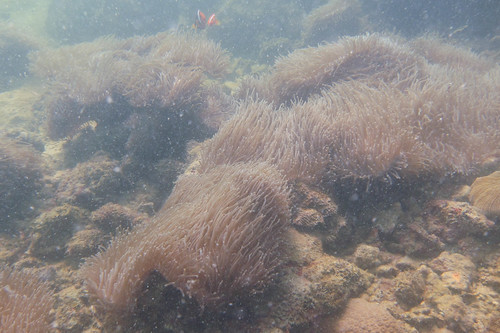
Anemone garden
Jeffrey Low and I visited the reefs of Terumbu Pempang, a massive submerged reef between Sudong Island and Hantu Island. After collecting the algae samples, I took a quick swim around the reef and chanced upon a whole reef slope covered with massive anemones and its anemonefish. I was blown away. Some of the anemones were over a meter and a half in diameter, and as I floated above them, I wondered how long they have been here. Anemones are known to live for several hundred of years, and it’s believed that they don’t have a lifespan, and continue to exist until something eventually kills them. If we can maintain or improve the condition of our seas, these anemones will continue to marvel divers for many many generations.
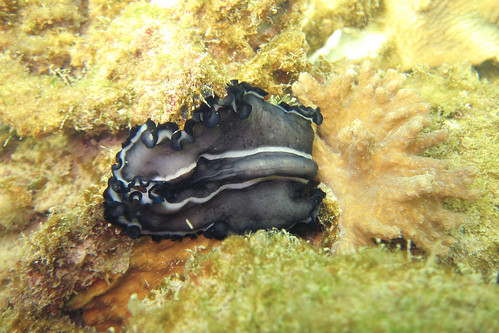
Marine flatworm
Common but no less exciting finds included marine flatworms like the one above. While collecting algae, I also found a thin black ribbon worm living in the algae. It could extend itself to over 20 times its length, which was a bit freaky to watch at first. I didn’t get to photograph it because it was really fragile and I didn’t want to handle it much more than needed. Jeffrey said he didn’t know the worm we found occurred in Singapore. Though I think it’s a ribbon worm, we’ll have to wait for Jeffrey and those at the lab to examine it under a microscope to confirm what it is! Can’t wait to find out!
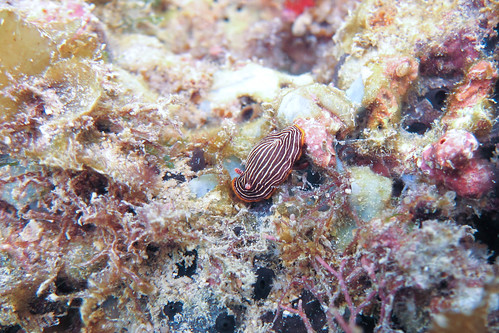
Nudibranch on reef flat
Less freaky critters encountered amidst the algae included this Chromodoris lineata. I saw about four species of nudibranch.
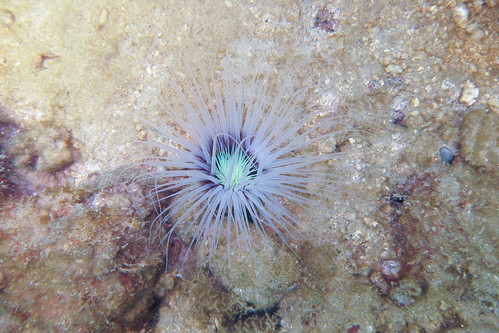
Peacock anemone
This thing that looks like a tubeworm is actually a Peacock anemone. Evidently, is it no peacock. Neither is it a true anemone. It’s also known as a tube-anemone, or tube-dwelling anemone. Read more about Peacock anemones.

Commensal shrimp on whip coral
As we were about to surface from our first dive, we ventured shortly onto the deeper end of the reef and found a really long whip coral with a pair of commensal shrimp perched on the top-end of the coral. The larger is the female, and Jeffrey mentioned that she might be gravid. The smaller one with the pincers is the male.
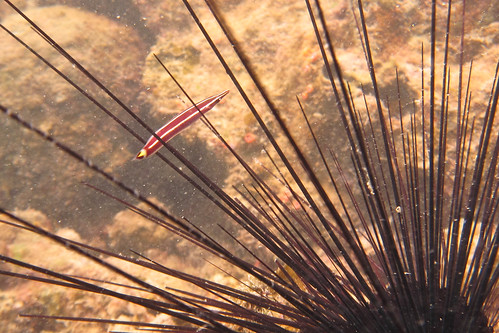
Clingfish in Diadema urchin
I saw many urchins over the past few days and was quietly willing to see a clingfish. My wishes were answered! The urchin provides the fish both protection and food. Though its common name is Urchin clingfish, it can also found associating with branching corals where it is known to prey upon parasitic bivalves that attack various species of corals.

Oriental sweetlips and Copper-banded butterflyfish
I saw more leopard grouper today, and another sweetlips. It’s good to see the big predatory fish on the reef. They wouldn’t be found around if they couldn’t find enough food, which makes them indicators for the health of a reef.
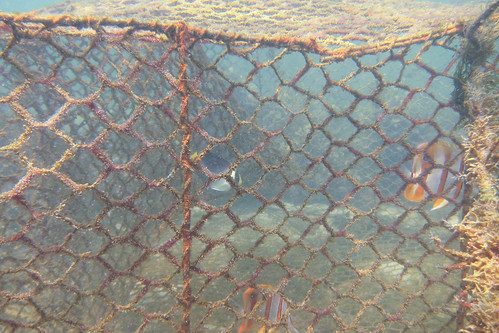
Yellow-finned angelfish and Copper-band butterflyfish in cage trap (bubu)
On our second dive, we came across a large fish trap (bubu) with some Copper-banded butterflyfish, two Barramundi (Asian seabass), a filefish, and some angelfish. Bubus are indiscriminate and target all species of fish on the reef. Fishing with bubus is not illegal. In fact, Singapore does not have any fishing laws. Anything you can find in the sea is free for the taking. Perhaps clear fishing laws will make it easier to distinguish what is or isn’t allowed on our reefs. Perhaps certain zones can be identified where certain methods of fishing are allowed. It would also be useful to specify what species can or cannot be fished/harvested, as well as size limits, and methods employed to catch these fish. Such regulations are easier to put into place than they are to enforce, but it would still be useful to get some guidelines down first. Some fishing groups and organisations have their own codes for fishing, but these need to be unified. it might also be a good idea for environment groups and fishing communities to come together to discuss how we can better manage our reefs to keep these activities sustainable, and their impact minimised.
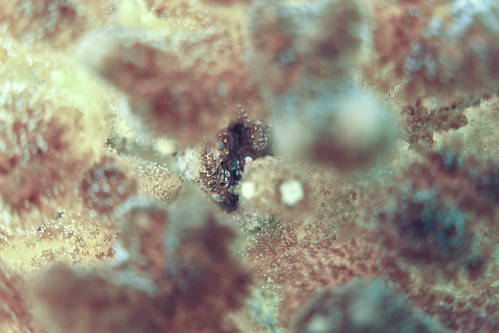
Crab in acopora coral
A quick peek into a colony of acopora coral reveals a little crab that was busy feeding, as well as a shrimp and goby.
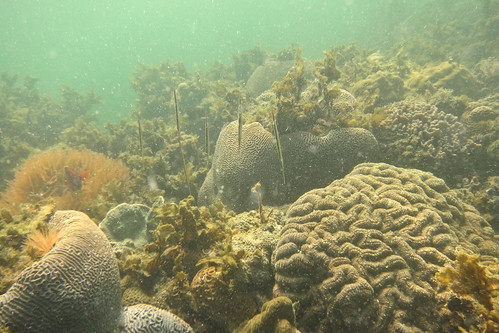
Razorfish
A school of razorfish swam around the reef flat as a couple of anemonefish look on.
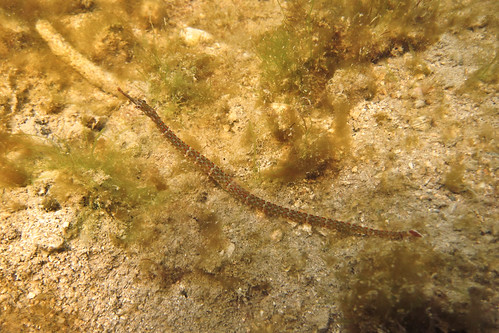
Rubble pipefish
A pipefish creeps along the algae.

Conch
I also found a large conch snail. Look at its eyes and huge foot! I tried waiting for it to flip itself over but I lost the waiting game, so I flipped it back over instead.
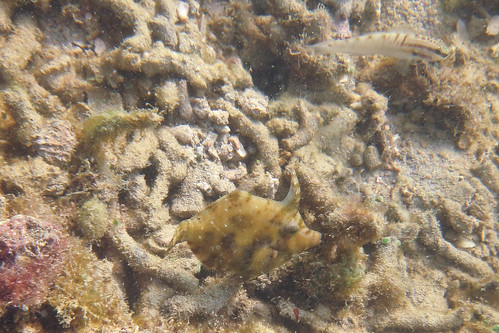
Filefish and goby
A filefish and goby in the coral rubble.
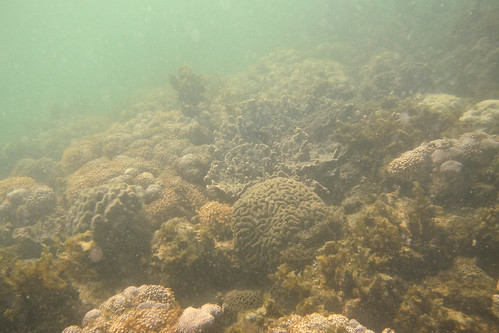
Coral reef
Most of the reef looked really good. One thing Jeffrey and I talked about, since we saw two cuttlefish nests over the past two days, was how uncommon it is to find colonies of branching coral. Just look at the above picture, not a branching coral colony in sight. Jeffrey mentioned that branching corals are quite sensitive to . That means cuttlefish, like some animals in Singapore forests like hornbills, need big trees, or in this case, branching corals, to nest. Perhaps future artificial reefs could take this into consideration; we often just focus on creating spaces for coral to colonise, but the reef also requires specific structures to meet the needs of some animals. Maybe future artificial reefs might have shapes and structures that mimic that of branching coral.
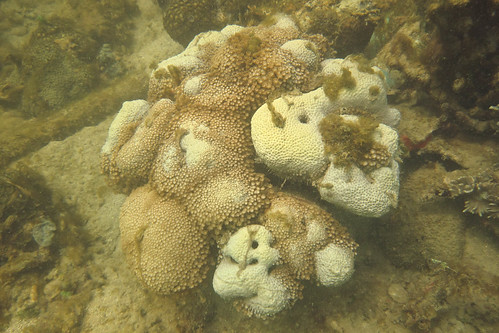
Coral bleaching
There were some coral that we found bleaching, like this colony of goniopora. Hopefully it is able to recover.
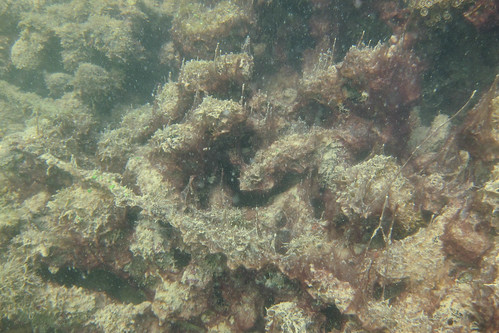
Sedimentation
It was very sad to see a whole section of Hantu’s reef slope decimated by sedimentation. When stressed, corals produce a mucous. In the picture, you can see that blue-green algae, or cyanobacteria, has already grown on top of the mucous and sedimentation. The picture below shows what this same reef looked like three years ago. So going back to what was mentioned at the top of this post – the reef is doing its best to work against the challenges we are presenting it, but sometimes its best is not enough. So we too need to do our best to give it its best chance. There is evidence that reefs and development can co-exist, but we need to be careful because somethings lost can’t be regained easily.
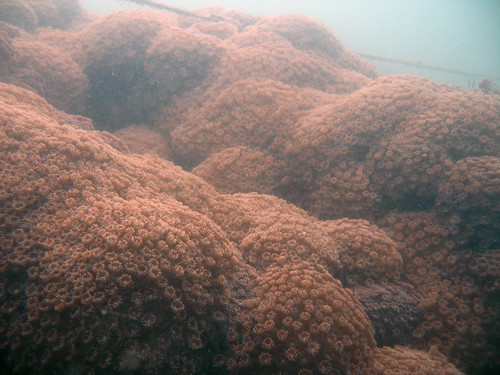
Goniopora on Hantu reef slope in 2009.
 Posted in
Posted in 



 content rss
content rss
COMMENTS